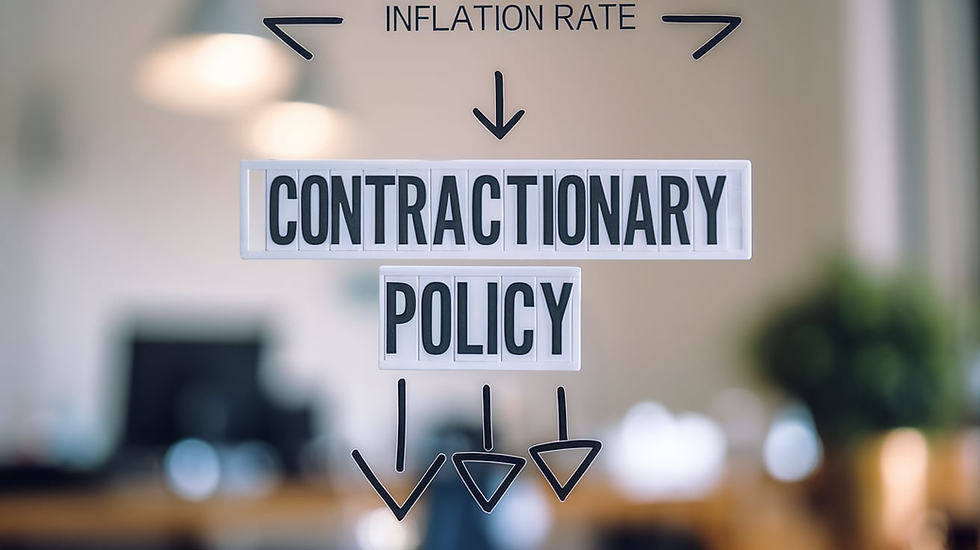Contractionary Policy Explained Simply
- Sofia Müller

- Sep 7
- 4 min read
Economies move in cycles — sometimes growing too fast and other times slowing down. When growth is too fast, inflation often rises, making goods and services more expensive. To control this, governments and central banks use something called a contractionary policy.
This policy reduces money supply or demand in the economy to slow things down and bring prices under control. While it may sound negative, contractionary policy is an important tool to maintain balance and long-term stability.
In this guide, I’ll explain what contractionary policy means, how it works, the tools used, and its real-world effects in simple, easy-to-understand terms.

What is Contractionary Policy?
Contractionary policy is a type of economic policy used to slow down economic growth and reduce inflation.
Goal: Control rising prices and prevent the economy from overheating.
Approach: Reduce spending, money supply, or borrowing.
Users: Governments (fiscal policy) and central banks (monetary policy).
For example, if inflation rises to 8%, a central bank might increase interest rates to make borrowing more expensive. This reduces spending, slows demand, and brings inflation down.
Types of Contractionary Policy
There are two main types of contractionary policy:
Contractionary monetary policy: Used by central banks, involving higher interest rates, reduced money supply, or increased reserve requirements for banks.
Contractionary fiscal policy: Used by governments, involving higher taxes or reduced public spending.
Both methods aim to reduce overall demand in the economy, but they use different tools.
Tools of Contractionary Monetary Policy
Central banks have several tools to slow down money growth:
Raising interest rates: Makes loans more expensive, reducing consumer and business borrowing.
Open market operations: Selling government bonds to pull money out of circulation.
Increasing reserve requirements: Forcing banks to hold more money instead of lending it.
Reducing money supply: Tightening liquidity to limit spending.
These tools directly affect how much money people and businesses can borrow and spend.
Tools of Contractionary Fiscal Policy
Governments can also use contractionary fiscal policy to reduce demand:
Raising taxes: Leaves households with less disposable income, reducing spending.
Cutting government spending: Reduces demand in areas like infrastructure or welfare.
Reducing subsidies: Increases prices, discouraging excess consumption.
Fiscal measures take longer to implement but can be powerful in managing demand across entire sectors.
Why Do Governments Use Contractionary Policy?
The main reason for using contractionary policy is to control inflation. If prices rise too fast, people lose purchasing power, savings lose value, and the economy becomes unstable.
Other goals include:
Preventing asset bubbles in housing or stock markets.
Reducing trade deficits by slowing imports.
Protecting long-term growth by avoiding runaway inflation.
While it slows growth in the short term, contractionary policy helps maintain stability in the long run.
Effects of Contractionary Policy
The impact of contractionary policy can be both positive and negative:
Positive effects:
Reduces inflation
Stabilizes currency value
Maintains investor confidence
Negative effects:
Slows economic growth
Increases unemployment
Reduces consumer and business confidence
This trade-off is why policymakers must apply it carefully, balancing inflation control with growth needs.
Contractionary Policy vs Expansionary Policy
These two policies are opposites:
Contractionary policy: Slows the economy by reducing spending and money supply.
Expansionary policy: Stimulates the economy by increasing spending and lowering interest rates.
Governments switch between the two depending on the economic cycle. For example, expansionary policy is common during recessions, while contractionary policy is used when inflation is high.
Real-World Examples of Contractionary Policy
Several historical cases show contractionary policy in action:
United States, 1980s: The Federal Reserve raised interest rates sharply to combat double-digit inflation, which later stabilized the economy.
India, 2010s: The Reserve Bank of India increased rates to control rising food and fuel inflation.
Eurozone, 2011: The European Central Bank used rate hikes to tackle inflation, though it later switched back to easing when growth slowed.
These examples highlight how central banks and governments use contractionary measures during inflationary times.
Conclusion
Contractionary policy may sound harsh, but it is a necessary tool for managing the economy. By reducing money supply or demand, it helps control inflation, stabilize currencies, and maintain long-term growth. While it can lead to slower economic activity or higher unemployment in the short run, the long-term benefits include stable prices and a stronger economy. Understanding contractionary policy gives you insight into how governments and central banks balance growth with stability.
FAQs
What is contractionary policy?
Contractionary policy is an economic measure used to slow down growth and reduce inflation. It involves raising interest rates, cutting government spending, or increasing taxes. Both governments and central banks use it to reduce demand in the economy and stabilize prices when inflation rises too high.
What are the tools of contractionary monetary policy?
The main tools are raising interest rates, increasing reserve requirements for banks, and selling government securities. These actions reduce the money supply, make borrowing more expensive, and discourage spending. Central banks use these measures to lower demand in the economy, helping to bring down inflation rates effectively.
How is contractionary policy different from expansionary policy?
Contractionary policy reduces demand to fight inflation, while expansionary policy increases demand to fight recession. For example, raising interest rates is contractionary, while cutting rates is expansionary. Governments and central banks shift between the two depending on whether the economy needs slowing down or boosting.
What are the effects of contractionary policy?
Contractionary policy reduces inflation, stabilizes currency, and prevents asset bubbles. However, it can also slow growth, increase unemployment, and lower consumer confidence. Policymakers must balance these effects carefully to achieve stability without causing too much harm to jobs and businesses. The timing and intensity of policy are crucial.
Can contractionary policy cause a recession?
Yes, if applied too aggressively, contractionary policy can push the economy into recession. By reducing spending and investment sharply, unemployment may rise, and businesses may suffer. This is why central banks and governments apply it carefully, often in gradual steps, to fight inflation without causing unnecessary economic slowdown.



Comments